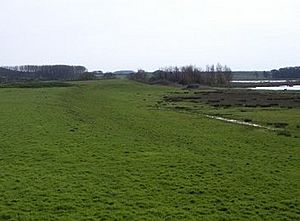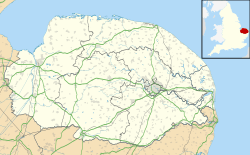Holkham Camp facts for kids

The fort, seen from the Joe Jordan bird hide to the north, is in the distance beyond the raised track
|
|
| Location | Near Holkham, Norfolk |
|---|---|
| Coordinates | 52°58′2″N 0°47′29″E / 52.96722°N 0.79139°E |
| Type | Iron Age fort |
| Area | 2.5 hectares (6.2 acres) |
| History | |
| Periods | Mesolithic, Neolithic, Iron Age |
| Cultures | Iceni |
| Designated | 4 December 1924 |
| Reference no. | 1018014 |
Holkham Camp, also known as Holkham Fort, is an ancient Iron Age fort located in Norfolk, England. It is about 1.6 kilometers (1 mile) northwest of the village of Holkham. This important historical site is protected as a scheduled monument.
Contents
Where is Holkham Camp Located?
Holkham Camp is found within the Holkham National Nature Reserve. It sits at the southern tip of a sandy piece of land that sticks out into the sea. To the north, there are coastal dunes, which are hills made of sand. On its other sides, the fort is surrounded by tidal wetlands, which are marshy areas that are sometimes covered by ocean water.
It's usually not possible to walk directly to the site. However, you can see it from a special raised bird hide. This hide is on the edge of some woods to the north.
Holkham Camp is also close to two other ancient Iron Age sites. It is about 8.8 kilometers (5.5 miles) north of Bloodgate Hill Iron Age Fort. It is also about 8 kilometers (5 miles) northwest of Warham Camp.
What Does Holkham Camp Look Like?
Holkham Camp is shaped like an oval. It covers an area of about 2.5 hectares (6.2 acres).
The western side of the fort is naturally protected by a steep slope. There is also a small creek on the southwest side. On the eastern side, the fort has a single rampart and a ditch. A rampart is a large bank of earth built for defense. There is also an extra outer bank on the southeast side.
On the south side of the fort, there is a gap in the banks about 9 meters (30 feet) wide. Experts believe this was the original entrance to the fort.
A Glimpse into Holkham Camp's Past
During the Iron Age and the Roman era, the area where Holkham Camp stands was home to the Iceni tribe. The Iceni were a powerful group of people who lived in what is now Norfolk.
Holkham Camp is one of two places that might match a description by the Roman historian Tacitus. He wrote about a battle in AD 47 where Iceni rebels were defeated by a Roman army. This army was led by a commander named Ostorius Scapula. The other possible site for this battle is Stonea Camp in Cambridgeshire.
People have also found tools made of flint at Holkham Camp. These tools date back to the Mesolithic (Middle Stone Age) and Neolithic (New Stone Age) periods. This suggests that the site might have been important even before the Iron Age. These flint tools were likely found where they were originally left, as the land has not been plowed.
Images for kids



